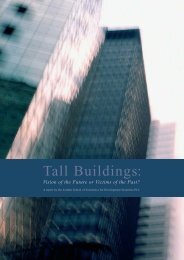Annual Report 2012 - Development Securities PLC
Annual Report 2012 - Development Securities PLC
Annual Report 2012 - Development Securities PLC
You also want an ePaper? Increase the reach of your titles
YUMPU automatically turns print PDFs into web optimized ePapers that Google loves.
g) Intangible assets<br />
(i) Goodwill<br />
Goodwill represents the excess of the cost of an acquisition over the fair<br />
value of the Group’s share of the net identifiable assets of the acquired<br />
subsidiary at the date of acquisition. Goodwill on acquisitions of subsidiaries<br />
is included in Intangible assets. Goodwill is tested annually for impairment<br />
and carried at cost less accumulated impairment losses. Impairment losses<br />
on goodwill are not reversed. Gains and losses on the disposal of an entity<br />
include the carrying amount of goodwill relating to the entity sold.<br />
Goodwill is allocated to cash-generating units (CGUs) for the purpose of<br />
impairment testing. The allocation is made to those CGUs that are expected<br />
to benefit from the business combination in which the goodwill arose,<br />
identified according to operating segment.<br />
(ii) Impairment of non-financial assets<br />
Assets that have an indefinite useful life, for example goodwill, are not<br />
subject to amortisation and are tested annually for impairment. Assets that<br />
are subject to amortisation are reviewed for impairment whenever events<br />
or changes in circumstances indicate that the carrying amount may not be<br />
recoverable. An impairment loss is recognised for the amount by which the<br />
asset’s carrying amount exceeds its recoverable amount. The recoverable<br />
amount is the higher of an asset’s fair value less costs to sell and value-inuse.<br />
For the purposes of assessing impairment, assets are grouped at the<br />
lowest levels for which there are separately identifiable cash flows (CGUs).<br />
Non-financial assets, other than goodwill, that have suffered an impairment<br />
are reviewed for possible reversal of the impairment at each reporting date.<br />
h) Revenue recognition<br />
(i) Rental income is recognised on a straight-line basis over the term of the<br />
lease. Incentives for lessees to enter into lease agreements are spread<br />
evenly over the lease term, even if payments are not made on such a<br />
basis. The lease term is the non-cancellable period of the lease together<br />
with any further term for which the tenant has the option to continue<br />
the lease, where, at inception of the lease, the Directors are reasonably<br />
certain that the tenant will exercise that option. Lease incentives are<br />
usually in the form of rent-free periods or capital contributions. Assets<br />
held within both the investment and development and trading segments<br />
earn rental income.<br />
(ii) Lease surrender payments from tenants are recognised in income when<br />
they are contractually agreed.<br />
(iii) Sales of property (both those classified as Investment and Inventory)<br />
are recognised when the risks and rewards of ownership have been<br />
transferred to the purchaser.<br />
(iv) Licence fee income from serviced offices is recognised on a straightline<br />
basis over the term of the licence. Other income from serviced<br />
offices is recognised when the service is provided. The income is<br />
classified within the operating segment.<br />
(v) Project management fee income is recognised over the contract term<br />
for which project management services are provided.<br />
(vi) <strong>Development</strong> revenue and profits are recognised in accordance with IAS<br />
11, ‘Construction contracts’ or IAS 18, ‘Revenue’ depending on whether<br />
all development risks, apart from the construction risk have passed to<br />
the purchaser under the terms of the development agreement.<br />
Financial Statements<br />
Where only the construction risk remains, the revenue and profit on the<br />
development is recognised under IAS 11, so as to match the proportion<br />
of development work completed on a percentage completion basis as<br />
determined by consultant monitoring surveyors or using a suitable<br />
method particular to the contract concerned. Profits are only recognised<br />
where the outcome can be determined with reasonable certainty. Full<br />
provision is made for losses as soon as such losses are foreseen.<br />
Where revenue and profit is recognised under IAS 18, disposals are<br />
recognised where the risks and rewards of ownership are considered to<br />
have been transferred to the purchaser. Profits are recognised within the<br />
development and trading segment.<br />
(vii) Finance income is recognised by reference to the principal outstanding<br />
using the effective interest method.<br />
(viii) Dividend income from investments is recognised when the Group’s right<br />
to receive income has been established.<br />
i) Investment properties<br />
(i) Investment properties are those properties, including land holdings, that<br />
are held either to earn rental income or for capital appreciation or both.<br />
Investment properties may be freehold or leasehold properties. For<br />
leasehold properties that are classified as investment properties, the<br />
associated leasehold obligations are accounted for as finance lease<br />
obligations if they qualify to be treated as such.<br />
(ii) Investment properties are measured initially at cost, including directly<br />
attributable transaction costs, and thereafter are stated at fair value.<br />
Surpluses and deficits arising from changes in the fair value of<br />
investment properties are recognised in the Statement of<br />
Comprehensive Income in the period in which they arise.<br />
(iii) Completed investment properties are valued, at each reporting date, by<br />
independent valuers on the basis of market value in accordance with the<br />
Appraisal and Valuation Standards of the Royal Institution of Chartered<br />
Surveyors. Fair value is assessed as the estimated amount for which a<br />
property should exchange on the date of valuation between a willing<br />
buyer and a willing seller in an arm’s-length transaction after proper<br />
marketing wherein the parties had each acted knowledgeably, prudently<br />
and without compulsion. A deduction is made to reflect purchaser’s<br />
acquisition costs. In determining the fair value, the capitalisation of net<br />
income method and the discounting of future cash flows to their present<br />
value have been used, which are based upon assumptions including<br />
future rental income, anticipated maintenance costs and appropriate<br />
discount rate, and make reference to market evidence of transaction<br />
prices for similar properties.<br />
(iv) Investment properties under construction are valued by the Directors, on<br />
the basis of the expected value of the property when complete, less<br />
deductions for the costs required to complete the project and<br />
appropriate adjustments for risk and finance costs. In preparing these<br />
valuations the Directors consult with agents and other advisors to derive<br />
appropriate assumptions specific to each asset.<br />
(v) Profits and losses on disposal of investment properties are calculated by<br />
reference to book value and recognised when the risks and rewards of<br />
ownership are considered to have passed to the purchaser. Gains and<br />
losses are recognised within ‘Gains or losses on disposal of investment<br />
properties’ in the Statement of Comprehensive Income.<br />
(vi) Investment properties held for sale are held at fair value and classified<br />
separately within current assets in the Balance Sheet.<br />
<strong>Development</strong> <strong>Securities</strong> <strong>PLC</strong> / <strong>Annual</strong> <strong>Report</strong> <strong>2012</strong> 73






